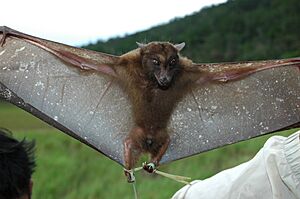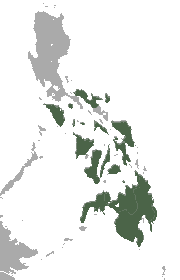Harpy fruit bat facts for kids
Quick facts for kids Harpy fruit bat |
|
|---|---|
 |
|
| Conservation status | |
| Scientific classification | |
| Genus: |
Harpyionycteris
|
| Species: |
whiteheadi
|
 |
|
| Harpy fruit bat range | |
The harpy fruit bat (Harpyionycteris whiteheadi) is a special kind of megabat found only in the Philippines. It's known for its unique face, which looks a bit like a mythical harpy! This bat helps spread seeds in its forest home.
Contents
Discovering the Harpy Fruit Bat
A British scientist named Oldfield Thomas first described the harpy fruit bat in 1896. He named it whiteheadi after John Whitehead, an English explorer. Whitehead found the first bats in the Philippines.
Whitehead collected these bats in December 1895 on Mindoro Island. He found them high up in the mountains, about 1,500 meters (5,000 feet) above sea level. Oldfield Thomas was very impressed with Whitehead's discoveries! For a long time, this was the only known species in its group, called Harpyionycteris.
What Does a Harpy Fruit Bat Look Like?
Harpy fruit bats are mostly dark brown on top and lighter brown underneath. They don't have a tail. However, they do have a small, furry membrane called a uropatagium between their legs.
These bats are about 14 to 15 centimeters (5.5 to 6 inches) long. They weigh between 83 and 142 grams (3 to 5 ounces). Their teeth are very unique. Their front teeth and canines lean forward. This makes their upper and lower canines cross over when their mouth is closed. Their back teeth, called molars, have five or six points, and their lower canines have three points.
What Do Harpy Fruit Bats Eat?
The harpy fruit bat is a frugivorous animal, which means it eats mostly fruit. They especially like to eat fruit from pandan plants and certain types of fig trees.
When these bats eat fruit, they also swallow the seeds. Later, they excrete the seeds in their droppings. This helps spread the seeds to new places. It's like the bats are planting new trees and helping the forest grow!
Life Cycle and Reproduction
Both male and female harpy fruit bats can start having babies when they are less than a year old. They have two main breeding seasons each year. The first season is from January to February. The second season is from July to August.
Female bats usually have one baby, called a pup, at a time. The mother carries the baby for about four to five months. After the pup is born, the mother feeds it milk for three or four months. Some female bats have two pups a year, one in each breeding season. Others only have one pup during the second season.
Where Do Harpy Fruit Bats Live?
Harpy fruit bats live on several islands in the Philippines. These islands include Biliran, Maripipi, Camiguin, Leyte, southern Luzon, Mindanao, Mindoro, Negros, Cebu, Masbate, and Samar.
They prefer to live in different types of forests, including old-growth forests, newer forests, and slightly disturbed mountain forests. You can find them from sea level up to about 1,800 meters (5,900 feet) high. They especially like habitats around 500 meters (1,600 feet) in elevation. Like other fruit bats, harpy fruit bats are active around dawn and dusk. They usually sleep in trees during the day, not in caves.
Protecting Harpy Fruit Bats
The number of harpy fruit bats is thought to be stable right now. The biggest danger they face is deforestation, which is when forests are cut down. However, this is not a huge threat to them yet. This is because most of the deforestation in their habitat happens at lower elevations, and these bats prefer higher areas.
Sometimes, these bats are hunted for food. Bat dishes are popular in some local areas for special events. However, it's not clear how much they are hunted. Some sources say they are "rarely if ever" hunted.


